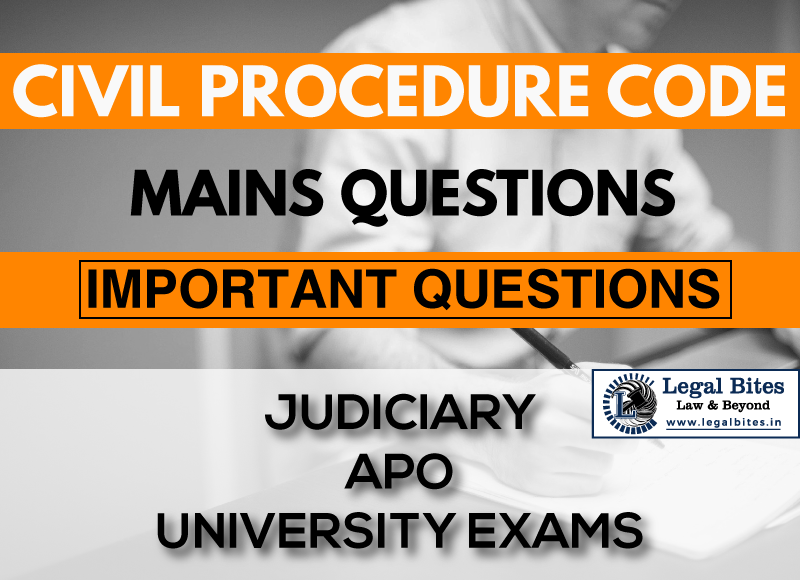Distinguish between necessary and proper parties
Find the answer to the mains question only on Legal Bites.;

Question: Distinguish between necessary and proper parties.Find the answer to the mains question only on Legal Bites. [Distinguish between necessary and proper parties.]AnswerNecessary Parties: Necessary parties are individuals or entities whose presence is essential for the complete and effective adjudication of a dispute. Their inclusion in the lawsuit is necessary to ensure that the court's decision is comprehensive and binding on all parties who have an interest in the subject matter...
Question: Distinguish between necessary and proper parties.
Find the answer to the mains question only on Legal Bites. [Distinguish between necessary and proper parties.]
Answer
Necessary Parties:
Necessary parties are individuals or entities whose presence is essential for the complete and effective adjudication of a dispute. Their inclusion in the lawsuit is necessary to ensure that the court's decision is comprehensive and binding on all parties who have an interest in the subject matter of the litigation. Failure to include necessary parties may result in an incomplete or inadequate resolution of the dispute.
The determination of whether a party is necessary depends on two main factors:
a. Complete and Effective Adjudication: A party is considered necessary if their presence is required to enable the court to fully and effectively determine all the issues involved in the case. The absence of a necessary party would hinder the court's ability to grant complete relief or to adjudicate all rights and claims related to the subject matter.
b. Risk of Multiple or Inconsistent Judgments: A party may also be deemed necessary if their exclusion from the lawsuit would lead to the risk of multiple lawsuits or inconsistent judgments. Including all parties with an interest in the subject matter helps avoid conflicting decisions and promotes judicial efficiency.
For example, in a case involving a dispute over the ownership of a property between two co-owners, both co-owners are necessary parties. Their inclusion is necessary to ensure that the court can effectively determine the rights and claims of all parties involved and provide a conclusive resolution to the dispute.
Proper Parties:
Proper parties, on the other hand, are individuals or entities who have a legitimate interest in the subject matter of the litigation, but their presence is not essential for the court to adjudicate the dispute. Unlike necessary parties, the absence of proper parties does not render the court's decision incomplete or inadequate. However, their presence may still be desirable to ensure a fair and comprehensive resolution of the matter.
While proper parties may have an interest in the subject matter, their rights are not directly affected by the court's decision. Their absence does not prevent the court from adjudicating the main dispute between the existing parties.
The court has the discretion to decide whether a party is a necessary or proper party based on the facts and circumstances of the case. The factors considered may include the nature of the dispute, the interests involved, and the potential impact of the judgment on the absent party.
It's worth noting that even though proper parties are not essential for the adjudication of the dispute, the court may allow their joinder in the lawsuit if it promotes judicial efficiency and avoids multiple or duplicative litigations.
In summary, the main distinction between necessary parties and proper parties lies in their level of indispensability to the court's decision-making process. Necessary parties are crucial for a complete and effective resolution of the dispute, while proper parties have a legitimate interest but their presence is not indispensable. Including necessary parties ensures a comprehensive adjudication, while proper parties, although not necessary, may be joined to promote fairness and efficiency in the litigation process.
Important Mains Questions Series for Judiciary, APO & University Exams
- CPC Mains Questions Series: Important Questions Part – I of X
- CPC Mains Questions Series: Important Questions Part – II of X
- CPC Mains Questions Series: Important Questions Part – III of X
- CPC Mains Questions Series: Important Questions Part – IV of X
- CPC Mains Questions Series: Important Questions Part – V of X
- CPC Mains Questions Series: Important Questions Part – VI of X
- CPC Mains Questions Series: Important Questions Part – VII of X
- CPC Mains Questions Series: Important Questions Part – VIII of X
- CPC Mains Questions Series: Important Questions Part – IX of X
- CPC Mains Questions Series: Important Questions Part – X of X


